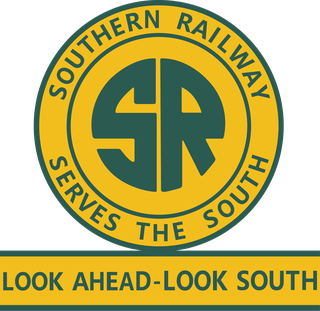
The Southern Railway was a class 1 railroad based in the Southern United States between 1894 and 1982, when it merged with the Norfolk and Western Railway (N&W) to form the Norfolk Southern Railway. The railroad was the product of nearly 150 predecessor lines that were combined, reorganized and recombined beginning in the 1830s, formally becoming the Southern Railway in 1894.

Auto Train is an 855-mile (1,376 km) scheduled daily train service for passengers and their automobiles operated by Amtrak between Lorton, Virginia, and Sanford, Florida. Auto Train is the only motorail service in the United States.

Auto-Train Corporation, stylized auto-train, was a privately owned passenger railroad that operated from 1971 to 1981. Its trains included autorack cars, enabling passengers to bring their own vehicles on their journey. The company used its own rolling stock, and traveled on rails leased from major railroads. It served central Florida from points in the Mid-Atlantic region near Washington, D.C., and the Midwest near Louisville, Kentucky. The company failed after 10 years despite the popularity of the service on its primary route, which parallels busy Interstate 95 in five states along the eastern U.S. coast.
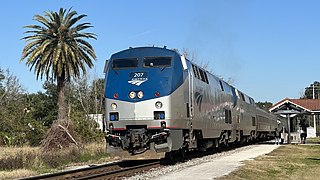
The Silver Meteor is a long-distance passenger train operated by Amtrak between New York City and Miami, Florida. Introduced in 1939 as the first diesel-powered streamliner between New York and Florida, it was the flagship train of the Seaboard Air Line Railroad (SAL) and one of the flagship trains of its successor, the Seaboard Coast Line Railroad (SCL). The train was transferred to Amtrak when it took over intercity passenger rail service in 1971.

The Silver Star is a long-distance passenger train operated by Amtrak on a 1,522-mile (2,449 km) route between New York City and Miami via Washington, D.C., Richmond, Virginia, Raleigh, North Carolina, Columbia, South Carolina, Savannah, Georgia, Jacksonville, Florida, and Tampa, Florida. The Silver Star and its sister train in the Silver Service brand, the Silver Meteor, are the descendants of numerous long-distance trains that operated between Florida and New York for most of the 20th century.

The Palmetto is a passenger train operated by Amtrak on a 829-mile (1,334 km) route between New York City and Savannah, Georgia, via the Northeast Corridor, Washington, D.C., Richmond, Virginia, Fayetteville, North Carolina, and Charleston, South Carolina. The Palmetto is a shorter version of the Silver Meteor, which continues south to Miami, Florida. From 1996 to 2002 this service was called the Silver Palm. Although currently a day train, the Palmetto is considered a long-distance train by Amtrak and previously provided overnight sleeper service to Florida.
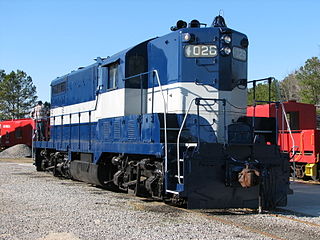
The Georgia Railroad and Banking Company also seen as "GARR", was a historic railroad and banking company that operated in the U.S. state of Georgia. In 1967 it reported 833 million revenue-ton-miles of freight and 3 million passenger-miles; at the end of the year it operated 331 miles (533 km) of road and 510 miles (820 km) of track.

The Central of Georgia Railway started as the Central Rail Road and Canal Company in 1833. As a way to better attract investment capital, the railroad changed its name to Central Rail Road and Banking Company of Georgia. This railroad was constructed to join the Macon and Western Railroad at Macon, Georgia, in the United States, and run to Savannah. This created a rail link from Chattanooga, on the Tennessee River, to seaports on the Atlantic Ocean. It took from 1837 to 1843 to build the railroad from Savannah to the eastern bank of the Ocmulgee River at Macon; a bridge into the city was not built until 1851.
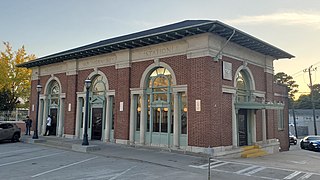
Atlanta Peachtree Station is a train station in Atlanta, Georgia. It is currently a service stop for Amtrak's Crescent passenger train. The street address is 1688 Peachtree Road, Northwest, in the Brookwood section of town between Buckhead and Midtown.

The International was a named passenger train operated between Chicago and Toronto. It was originally an overnight train operated by the Grand Trunk Railway of Canada and its successors the Canadian National Railway and Grand Trunk Western Railroad, running as far as Montreal. The train was cut back to Port Huron, Michigan, in 1970 and discontinued in 1971.

Savannah station is an Amtrak train station in Savannah, Georgia. The station was built in 1962 to replace the older Savannah Union Station, torn down for construction of I-16. Located at 2611 Seaboard Coastline Drive, the station consists of a terminal building on the east side of the north–south tracks, with a platform between the tracks.
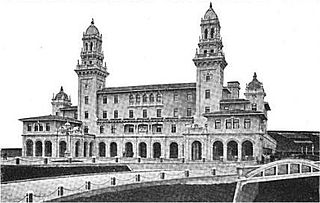
Terminal Station was the larger of two principal train stations in downtown Atlanta, Union Station being the other. Opening in 1905, Terminal Station served Southern Railway, Seaboard Air Line, Central of Georgia, and the Atlanta and West Point. The architect was P. Thornton Marye, whose firm also designed the Fox Theater and Capital City Club in downtown Atlanta, as well as the Birmingham Terminal Station.

The Union Station built in 1930 in Atlanta was the smaller of two principal train stations in downtown, Terminal Station being the other. It was the third "union station" or "union depot", succeeding the 1853 station, burned in mid-November 1864 when Federal forces left Atlanta for the March to the Sea, and the 1871 station.

The Royal Palm was a named train of the Southern Railway that ran from Cincinnati, Ohio, to Jacksonville, Florida, and then on the Florida East Coast Railway's East Coast Champion to Miami, Florida. The train was discontinued in 1970.
The Georgia Rail Passenger Program (GRPP) was a set of plans, as yet unbuilt, for intercity and commuter rail in the U.S. state of Georgia.

Central of Georgia Depot and Trainshed is a former passenger depot and trainshed constructed in 1860 by the Central of Georgia Railway (CofG) before the outbreak of the American Civil War. This pair of buildings was declared a National Historic Landmark in 1976, a listing that was expanded in 1978 to the old Central of Georgia Railway Savannah Shops and Terminal Facilities.

The Champion was a streamlined passenger train operated by the Atlantic Coast Line Railroad and Florida East Coast Railway between New York City and Miami or St. Petersburg, Florida. It operated from 1939 until 1979, continuing under the Seaboard Coast Line and Amtrak. It was a direct competitor to the Seaboard Air Line Railway's Silver Meteor, the first New York-Florida streamliner.
The transportation system of Georgia is a cooperation of complex systems of infrastructure comprising over 1,200 miles (1,900 km) of interstates and more than 120 airports and airbases serving a regional population of 59,425 people.

The City of Miami was a seven-car coach streamliner inaugurated by Illinois Central Railroad on December 18, 1940. Its route was from Chicago to Miami a total distance of 1,493 miles (2,403 km).

Terminal Station, Macon, Georgia, is a railroad station that was built in 1916, and is located on 5th St. at the end of Cherry St. It was designed in the Beaux-Arts style by architect Alfred T. Fellheimer (1875–1959), prominent for his design of Grand Central Terminal in New York City in 1903. The station building is part of the Macon Historic District, which is listed on the National Register of Historic Places. While no longer an active train station, it has been the location of the Macon Transit Authority bus hub since 2014.



















